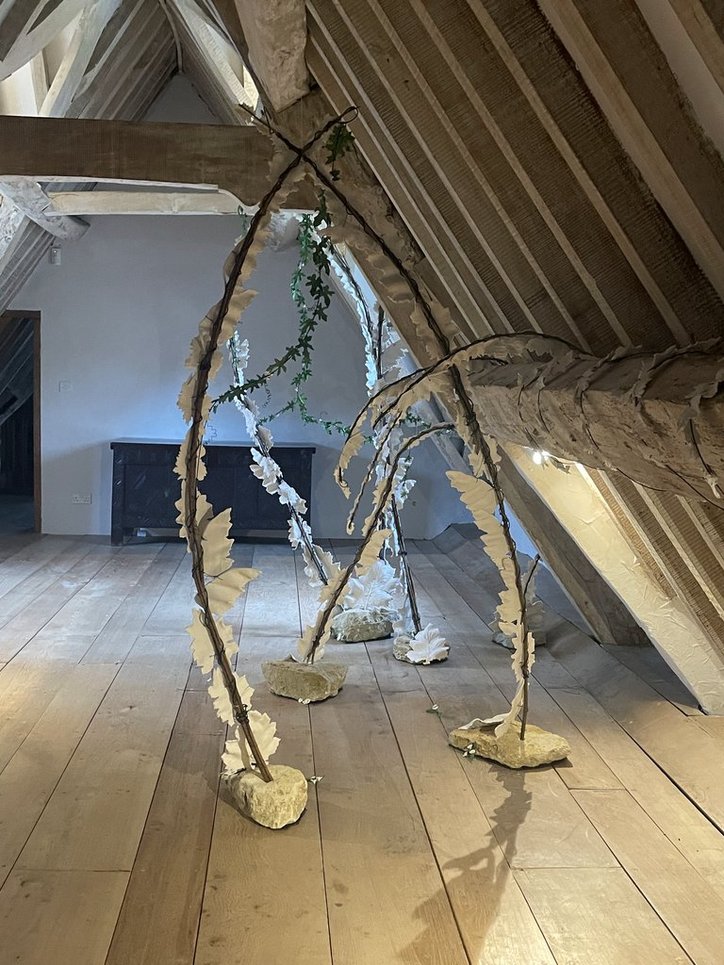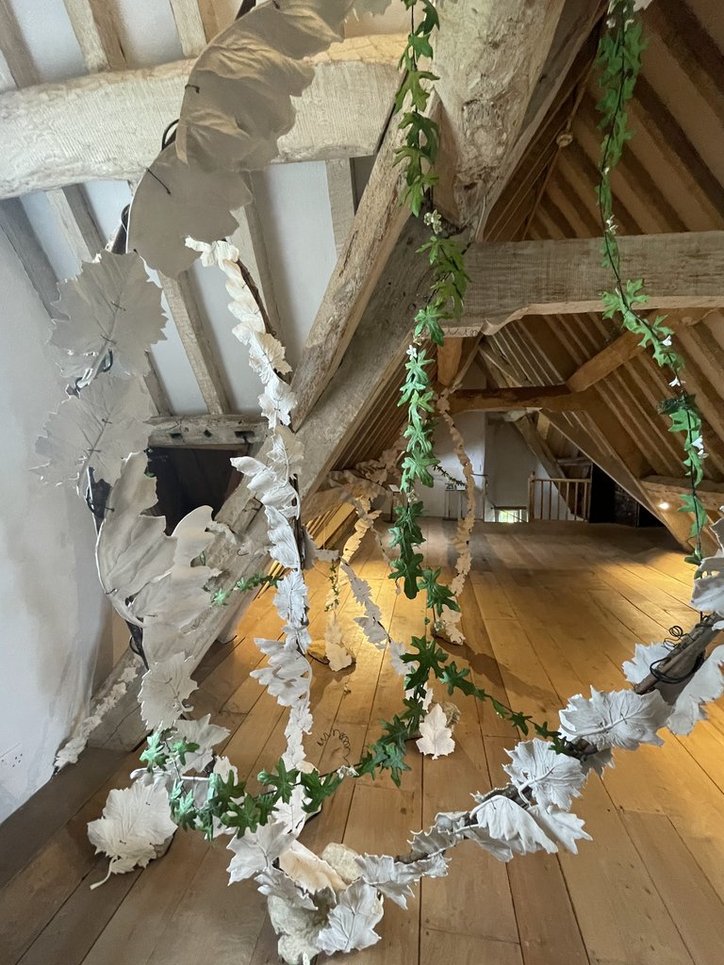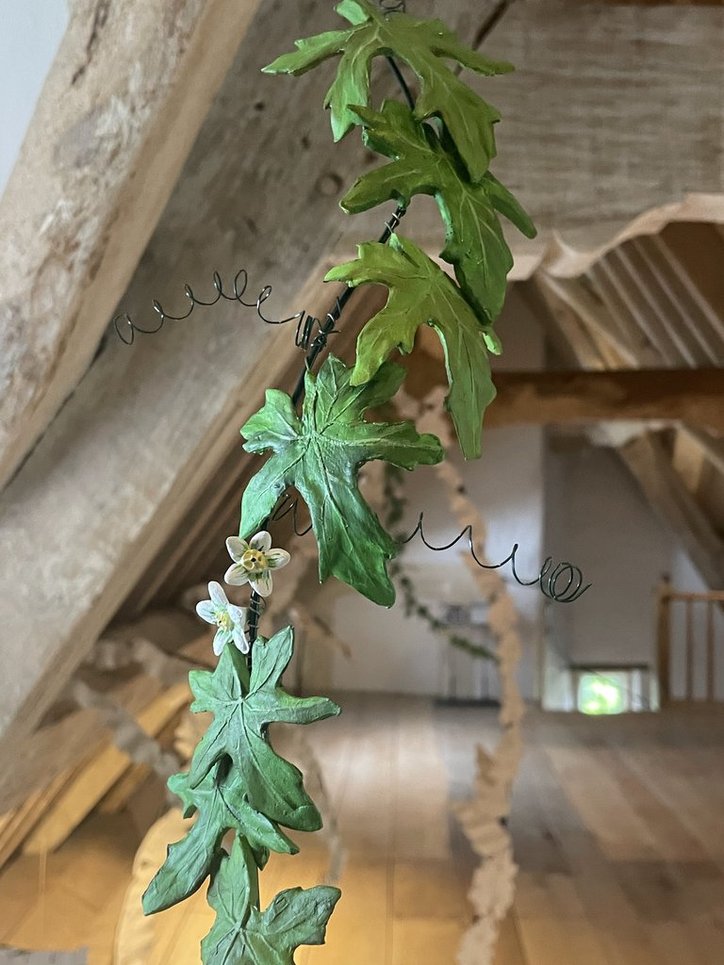2023 Maker in Residence
The Society of Antiquaries of London, in partnership with Heritage Crafts, is thrilled to introduce ceramicist Alison Proctor as the Maker in Residence for 2023 at Kelmscott Manor. Our historic residence will be the backdrop for Alison’s residency from June to October 2023.
“I am excited by the prospect of our first Maker in Residence at Kelmscott Manor and delighted that the Society is working in partnership with Heritage Crafts, an organisation that champions the handmade and shares in so many of our own values and those of William Morris.”
– Martin Millett, President of the Society of Antiquaries of London
Through this unique partnership, Alison will have the opportunity to honour Morris’s advocacy of craftsmanship and the handmade while contributing to his enduring legacy through active participation in Kelmscott Manor’s engaging public programmes.
“I am very much looking forward to immersing myself in the history and special setting of Kelmscott Manor. I’m excited to use the opportunity to explore new work and share my passion for craft and nature in a place that celebrates both.”
– Alison Proctor, 2023 Maker in Residence
For details of Alison’s workshops and demonstrations please visit our Events page
Maker Bio
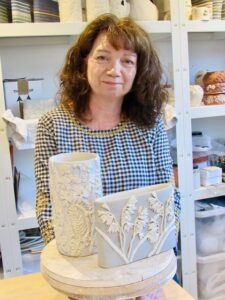
Alison Proctor is a ceramicist based in Kent whose predominantly sculptural work is inspired by the natural world. Her sculptures, often made using red and white earthenware clay, reflect a deep connection to her surroundings. Additionally, Alison has been experimenting with sea clay sourced from nature and reclaimed bone china, expanding the range of her artistic endeavours. Her recent work focuses on the tradition of casting sprig molds directly from plants and leaves, capturing their intricate beauty in delicate detail.

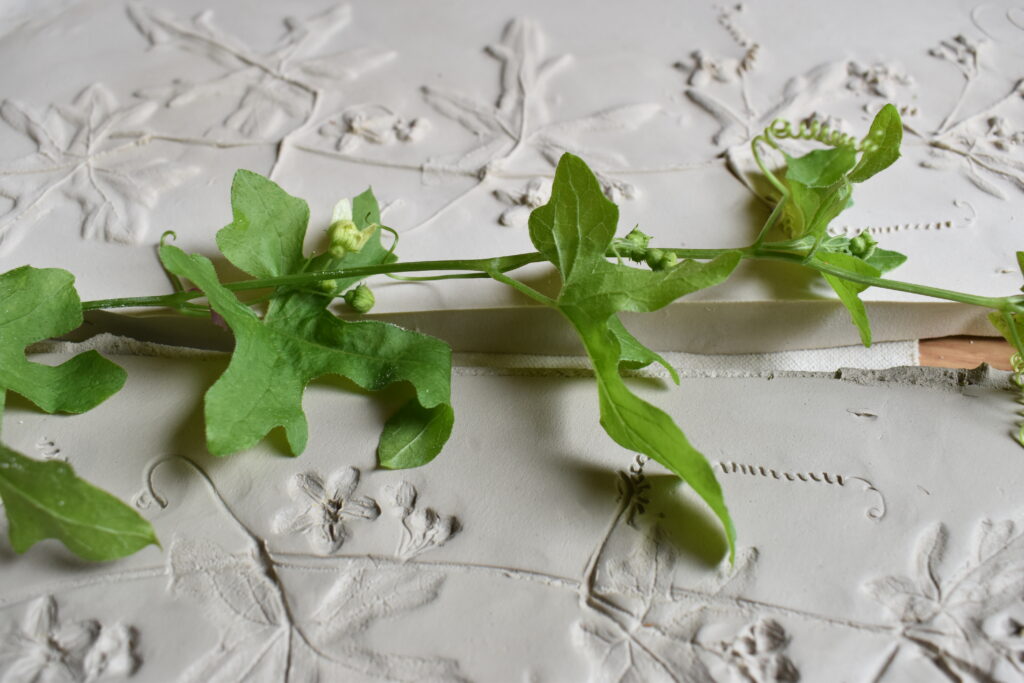
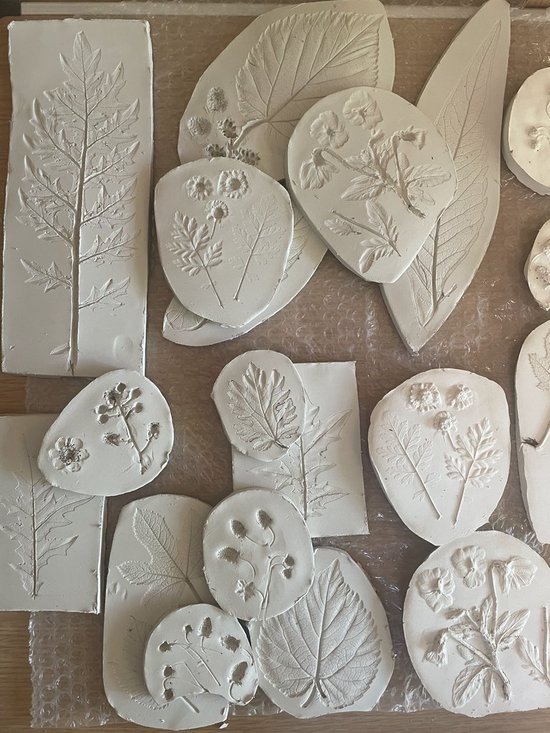
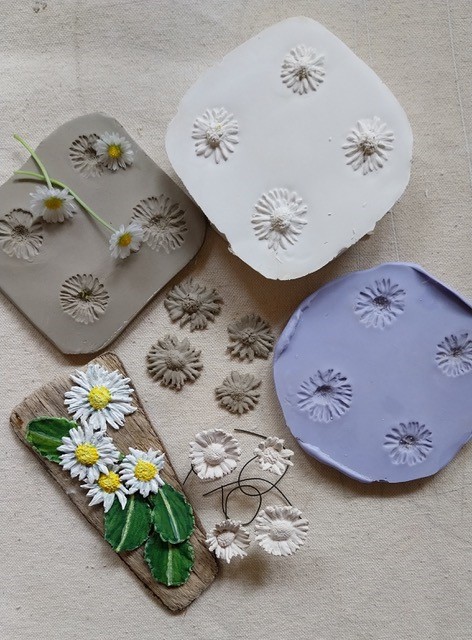
Find out more about Alison and her work here.
Alison Proctor’s appointment as the Maker in Residence is made possible as part of our NHLF- funded £6 million Kelmscott and Morris: Past, Present and Future project.
Interview with Alison Proctor
Our Learning and Outreach Officer, Dr. Hannah Britton, recently sat down with Alison to discover more about the process of Sprig Moulding and the installation that has been created as part of the residency.
What is the craft of sprig moulding?
Sprig moulding is the craft of creating a clay cast relief of an object, whether cast directly from the actual object, or from an object modelled by hand. This cast is then either applied to another clay vessel or to be its own 3D relief piece.
How is it a part of your practice?
I have been using the craft of making sprigs to cast directly from nature and record the flora from my garden or countryside around where I live in Kent / Sussex. I then apply the clay sprigs to pieces that I either throw on the wheel to become vases or as part of flower pieces that are hand modelled.
It becomes a form of documentation, like a nature diary of the passing seasons, holding on to permanent record of the ephemeral.
How have you been using it within the residency?
I have been using this craft to record plants growing in the Kelmscott Manor garden and meadows, to create sprigs that are used in several ways.
- To create 3 dimensional representations of the acanthus plant, the wild flower bryony and daisies that can be used in the installation. Both as undecorated and decorated.
- To use these sprig casts and other wild flowers to make sprigs that can be used to become part of a sculptural piece.
- To use the acanthus and mulberry sprigs to decorate bird feeders for the garden.
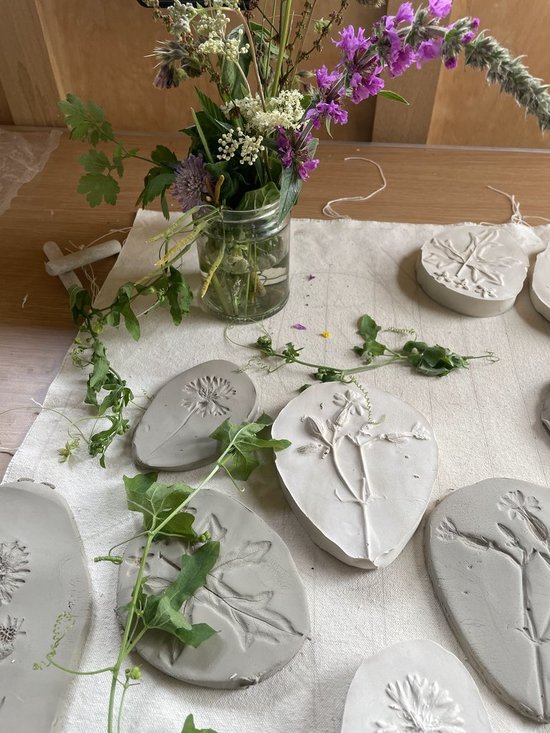
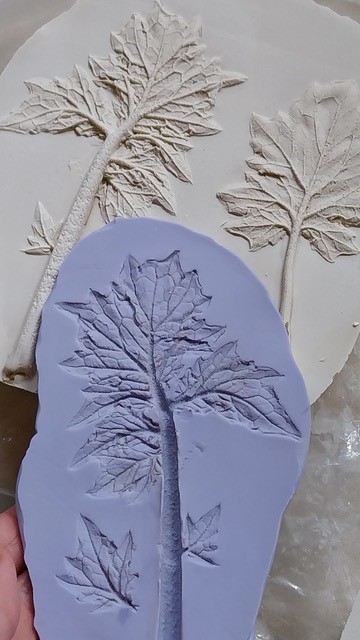
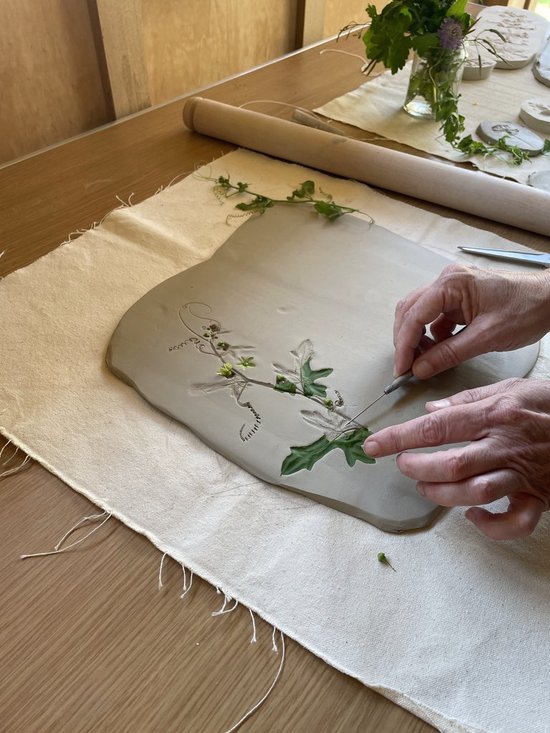

What is the inspiration behind the installation?
I wanted to make a work that reflected the garden and meadows at Kelmscott and continue to bring attention to Morris’s passion for nature and importance of the environment. I wanted to represent the layers of history within the manor intertwined with the flora surrounding it.
The designs and fabric within the manor are full of references to the plants within the garden and surrounding countryside…. I enjoyed finding all the depictions of daisies in embroideries, brass rubbings, tapestries and wallpapers.
I wanted to bring the outside into the manor and link the more formal designs with the wilder meadow flowers outside.
The acanthus is such a recognisable plant within Morris’s designs, and that became the starting point. The way it flows through Morris’s designs was something I wanted to bring up into the beautiful arches of the attic. I had also been taking casts of many of the meadow plants and discovered the bryony plant loving its vine like features and its beautiful flowers. This felt like the perfect plant to spiral and wind it’s way around the acanthus leaves in the installation.
The daisies echo those I found in the manor artefacts and are placed at floor level to give the feeling of wildflowers growing up into the attic and also reflect how much we may miss in nature – as not everyone spots them!
It was only after making this decision that by chance I came upon photos of May Morris’ embroidery design Fruit Garden, which features bryony winding around acanthus. It felt like a very happy coincidence and that I had quite naturally followed in her footsteps here at Kelmscott.
The clay I work with is white earthenware from Stoke on Trent. I decided to keep the acanthus leaves undecorated in their fired white bisque form and the bryony and daisies were decorated with acrylic. I felt this would give the acanthus a slightly ghostly appearance and stand out more in the half light of the attic – with a slight nod to the history of Kelmscott and the wildflowers very much in the present day showing the determination of nature.
Why did you choose these materials?
Clay is the medium I work in as a ceramicist and its malleable nature means it’s perfect for press moulding directly from plants and creating naturalistic 3D sprigs.
It felt important that all the elements of the installations were connected to the house and garden in some way, so I used branches from the old ash tree in the front garden and hazel to give more strength. These were held in position in Cotswold stone left over from the renovations.
How does the installation relate to your usual practice?
This type of work is not a usual part of my practice, as my work is mainly small individual pieces. But it is a scaled up version of the processes I use when making sprigs.
Can you tell us about the process of constructing the installation?
I knew that I wanted the piece to feel immersive and follow the flowing lines of Morris’s designs, so I had to work out how to hang the ceramic pieces, without attaching anything to the beams or walls of the attic. My initial thoughts of suspending just wires was not stable enough, so I was very fortunate to be allowed to bring branches from the grounds into the house. These would form the arch like framework upon which the ceramic sprigs could be attached.
After being treated with constain and wrapped in wire for additional support, the branches were placed in a series of arches, and suspended from the beams with fishing wire.
Raymond who works for Kelmscott, gave me a lot of help and support in bringing this framework of branches together and installing it. I very much enjoyed working with him and his contribution was invaluable.
Each acanthus sprig was threaded with a thin wire and then attached directly to the branches following the curves. The bryony leaves and flowers were attached to wire, suspended from the branches.
How does it feel to have your work in the Manor?
It is a huge privilege to have my work in the Manor along side so many beautiful Morris artefacts and heritage pieces. I hope the installation continues the legacy of Morris’s interest in the environment around him. To bring a contemporary and different perspective to the 2D flat designs, giving them 3 dimensions and bringing them into the present.
Why did you want this piece to be collaborative?
It felt right to echo Morris’s passion for communal working into this piece – of having many hands working together to create something. It also gave visitors the opportunity to connect to Kelmscott in a more interactive way and hopefully think more about the plants growing in the grounds and why Morris might have been so interested in them.
Has creating the installation influenced your practice or inspired you to think differently?
I have always wanted to create something choreographic and installational in nature. So I hope it will give me the confidence to be braver with creating public work in future. To work at a much larger scale has also been exciting and fulfilling, and something I want to do more of.
What else are you up to as part of the residency?
As well as the workshops and demonstrations that have accompanied the installation and residency so far, there will be also be a school’s workshop and adult daylong workshop.
These workshops will give the opportunity to share my making processes in more detail and participants will be able to create their own sprigs, from gathering plant material, casting and the final sprig.
I am also making a special sculptural piece for the Kelmscott Manor collection that will reference the ideas in the installation, as well as a series of ceramic bird feeders for the garden.
You can see Alison’s installation until the end of October 2023 in the attic of Kelmscott Manor.


